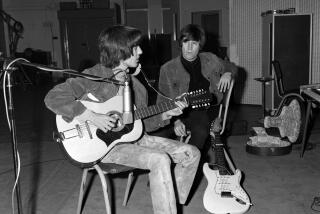Mapplethorpe Works Draw Top Dollar : Art: Sotheby’s rings up big sales as bids easily surpass auction estimates. Dealers believe the late photographer’s market value will continue to climb.
- Share via
NEW YORK — When the final gavel fell on Thursday, Sotheby’s closed a four-day round of photography auctions and rang up another string of big sales for the late Robert Mapplethorpe.
A trio of floral still lifes--”Orchid,” “Hyacinth” and “Vase of Irises”--brought $60,500, and a dye transfer print of a poppy (“Poppy”) sold for $35,750. Both sales more than doubled Sotheby’s high estimates.
Three of the artist’s self-portraits also commanded astonishing prices. “Self-Portrait (With Gun and Star),” valued at $20,000 to $25,000, brought $38,500. The sale easily broke the $17,600 auction record for a single Mapplethorpe work, set on Monday at Christie’s. “Self-Portrait in Leather Jacket” and “Self-Portrait in Drag,” each estimated at $10,000 to $15,000, brought $35,750 apiece.
“His market is very strong, and not just because of the controversy, though Robert would have loved that. If you believe in the hereafter, you can imagine him up there chortling,” said Paris photography dealer Harry H. Lunn.
“I paid about $3,000 apiece in 1987 for some of his self-portraits and offered them for $8,000 in the Paris art fair that year. At the Basel art fair this year, ‘Self-Portrait (With Gun and Star)’ was going for $15,000 and it sold here today for $38,500,” he said. Lunn said he is holding the Mapplethorpes he owns because he thinks the prices will go much higher.
London dealer Tim Jefferies, who recently outpaced the auction houses by selling a Mapplethorpe print for $50,000 at his Hamiltons Gallery, said that Mapplethorpe’s market is probably stronger in Britain than in the United States.
Christie’s and Sotheby’s sold about 1,200 photographs this week for a total of $6.28 million. Sotheby’s $3.58-million auction was the New York firm’s biggest photography sale to date.
Only 41 of the photographs in the week’s sales were the work of Mapplethorpe, but they attracted attention partly because they were sold in conjunction with his collection of art and furniture. The photography auctions also provided the first public test of Mapplethorpe’s market in the midst of a controversy over government funding of art.
Who is buying Mapplethorpe? It was impossible to tell at Sotheby’s Thursday sale where most bidding and nearly all buying took place by telephone or by advance bids placed with the auction house.
Earlier in the week, some buyers, such as Florida dealer Ken Mazik, followed each sale assiduously and made purchases from Mapplethorpe’s collection as well as his photographs. Others who only attended the estate sale professed no interest in the artist.
“The fact that Robert Mapplethorpe owned this material has nothing to do with my buying it,” said New York collector Dennis Schnagel, who dashed in to bid on a pair of gilt bronze ewers and a bust of a satyr, and left as soon as he snagged them.
One private dealer who bought several pieces of neoclassical statuary said her anonymous client was interested in Mapplethorpe and that period of sculpture.
Others were completely turned off by the spectacle. “I find this business of grave robbing and selling every button and bauble of people like Warhol and Mapplethorpe extremely odious, particularly when you consider how they conducted their lives. I think people are getting tired of it and looking for other values,” said one New York dealer who stayed away from the auctions.
Mapplethorpe reportedly liked to be compared to Warhol, but the differences between them are as striking as the similarities.
The two artists thrived on publicity, connecting themselves to high society as well as New York’s underworld. But while Warhol passively watched a world of sex and drugs, Mapplethorpe prided himself on being a participant in bathhouse parties and a member of the whip-and-chain set.
Both were obsessive collectors, but Mapplethorpe was relatively restrained. He artfully displayed his collection in his Chelsea loft and once sold a collection of photographs. Warhol filled most of his six-floor townhouse with boxes of his purchases and never got rid of anything.
Mapplethorpe’s auction and foundation are patterned after the Warhol model, though on a notably smaller scale. Most of Mapplethorpe’s belongings were sold on Tuesday for a total of $2.27 million. When the few remaining pieces of art are cashed in--including a Warhol painting valued at about $1 million--the total will probably reach $4 million to $5 million.
Those proceeds plus money from the sale of some real estate will support the Robert Mapplethorpe Foundation to benefit AIDS research and photography collections and projects in major museums.
The Warhol auction last year at Sotheby’s was a 10-day marathon that racked up $25.3 million. Proceeds went to the Andy Warhol Foundation for the Visual Arts, which benefits nonprofit organizations that are involved with exhibitions, art education, historic preservation and urban planning. Earlier this year, the Warhol foundation made 58 grants totaling nearly $2 million.
More to Read
The biggest entertainment stories
Get our big stories about Hollywood, film, television, music, arts, culture and more right in your inbox as soon as they publish.
You may occasionally receive promotional content from the Los Angeles Times.









